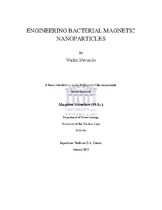| dc.description.abstract | Magnetosomes, produced by magnetotactic bacteria (MTB), are the most attractive alternative source of non-toxic biocompatible magnetic nanoparticles (MNPs). A magnetosome contains Fe2O4 magnetite with properties superior to MNPs synthesized by the traditional chemical route. However, synthesis of magnetosomes on large scale has not been achieved yet because magnetotactic bacteria are fastidious to grow. In addition, magnetosomes are generally “soft” magnetic materials which can only be used for some applications, while other applications require “hard” magnetic materials. Here at the Institute of Microbial Biotechnology and Metagenomic (IMBM), a study is being conducted on cloning and expression of the magnetosome gene island (MIA), the genetic machinery for magnetosome formation, in an easy to culture E. coli strain. The magnetic properties of the magnetosome can be manipulated by doping with divalent metals such as Ni2+ or Co2+ for a variety of applications. The specific objective of this study was to genetically engineer E. coli strains which accumulate intracellular Ni2+ or Co2+ in order to manipulate the magnetic properties of the magnetosomes. Three E. coli mutants and a wild type strain were transformed with high affinity Ni2+ or Co2+ uptake genes and evaluated for intracellular accumulation at different medium concentrations of NiCl2 or CoCl2. Cellular iron and magnesium were also evaluated because iron is the major component of the magnetosome and magnesium is important for cell growth. The wild type strain, EPI 300 habouring Ni2+ uptake permease the hoxN gene or Co2+ uptake ABC type transporter cbiKMQO operon was found to accumulate the most intracellular Ni2+ or Co2+ in medium conditions most likely to induce magnetosome formation and magnetite manipulation. This strain can be used to co-express the MIA and Ni2+ or Co2+ uptake gene for mass production of magnetosome with altered magnetic properties. | en_US |

